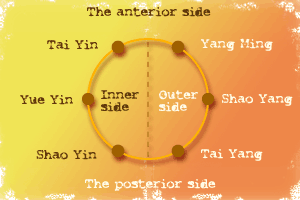|  |
|
| |
 |
 |
| Home > Basic Principles > The Twelve Meridians > Distribution of the twelve meridians in the body |
 |
 |
 |
| |
The twelve meridians are named according to their corresponding organs, limb positions and yin and yang properties. They include three arm yin meridians (lung, pericardium, heart), three arm yang meridians (large intestine, triple burner, small intestine), three leg yang meridians (stomach, gall bladder, bladder), and three leg yin meridians (spleen, liver, kidney). The triple burner and the pericardium do not refer to anatomical structures. They are functional units in Traditional Chinese Medicine (TCM). It should also be noted, the organs mentioned here have a much broader meaning in TCM then what is typically thought of their functions in western medicine. Since the twelve meridians make up the majority of the Meridian System, they are known as the regular or principal channels.
| Name of the twelve Meridians |
| Arm/ Leg |
Yin/ Yang |
Three Yang/ Three Yin |
The Twelve Meridians |
| Arm |
Yin |
Tai Yin |
Lung Meridian |
| Shao Yin |
Heart Meridian |
| Jue Yin |
Pericardium Meridian |
| Yang |
Yang Ming |
Large Intestine Meridian |
| Tai Yang |
Small Intestine Meridian |
| Shao Yang |
Triple Burner Meridian |
| Leg |
Yin |
Tai Yin |
Spleen Meridian |
| Shao Yin |
Kidney Meridian |
| Jue Yin |
Liver Meridian |
| Yang |
Yang Ming |
Stomach Meridian |
| Tai Yang |
Bladder Meridian |
| Shao Yang |
Gall Bladder Meridian |
|
|
Distribution of the twelve meridians in the body
The twelve Meridians have lateral and symmetrical distribution on the head, face, trunk and limbs. The six yin meridians are distributed on the inner side of the limbs and on the chest and abdomen. The six yang Meridians are distributed on the outer side of the limbs and on the head, face and trunk.
As shown in the diagram, the order and arrangement of the three yang meridians for both arms and legs are as follows: a) Yang Ming (meaning sunlight yang) has an anterior position. b) Shao Yang (meaning lesser yang) has a middle position. c) Tai Yang (meaning greater yang) has a posterior position. The three names have described the variation of yang qi (pronounced chee). They can also be interpreted as describing the variation of sunlight received. Since most animals' backs receive the greatest amount of sunlight, the back or posterior region is usually named as the Tai Yang position. Similarly, the position of Shao Yang and Yang Ming are located at more anterior regions where less sunlight is received.
The order and arrangement of the three yin meridians are as follows: a) Tai Yin (meaning greater yin) has an anterior position. b) Jue Yin (meaning absolute yin) has a middle position. c) Shao Yin (meaning lesser yin) has a posterior position. Again, the three names have described the variation of yin Qi and the degree of darkness at that position. The following figure has illustrated the general distribution of Meridians on the limbs.
|
 |
The twelve meridians follow specific time schedules and pathways. The Huang Di Nei Jing (The Yellow Emperor's Classic of Internal Medicine) says, " The three yins of the arm go from the organs to the hands. The three yangs of the arm go from the hands to the head. The three yangs of the legs go from the head to the feet. The three yins of the legs go from the feet to the abdomen." Qi is continuously circulating through the meridians in a daily cycle. At certain times, both qi and blood have maximum flow in particular meridians which are outlined below.
Meridian Flow Chart (The Daily Qi Current of the 12-hour Division)
|
|
| Arm |
|
Leg |
| Yin/Interior |
|
Yang/Exterior |
|
Yang/Exterior |
|
Yin/Interior |
Arm Tai Yin
Lung Meridian
(3am - 5am) |
 |
Arm Yang Ming
Large Intestine Meridian
(5am - 7am ) |
 |
Leg Yang Ming
Stomach
Meridian
(7am-9am) |
 |
Leg Tai Yin
Spleen Meridian
(9am-11am) |
|
|
Arm Shao Yin
Heart Meridian
(11am-1pm) |
 |
Arm Tai Yang
Small Intestine Meridian
(1pm-3pm) |
 |
Leg Tai Yang
Bladder Meridian
(3pm-5pm) |
 |
Leg Shao Yin
Kidney Meridian
(5pm-7pm) |
|
|
Arm Jue Yin
Pericardium Meridian
(7pm-9pm) |
 |
Arm Shao Yang
Triple Burner Meridian
(9pm-11pm) |
 |
Leg Shao Yang
Gall Bladder Meridian
(11pm-1am) |
 |
Leg Jue Yin
Liver Meridian
(1am-3am) |
|
|
|
As shown in the above chart, qi is more prevalent in different meridians at different times. For example, from 3am to 5am, meridian qi mainly flows through the Lung Meridian and enters the Large Intestine Meridian at 5am-7am, and then the Stomach Meridian from 7am-9am. In this way, the meridian cycle is continuous as the qi flows through the body.
Exterior-Interior relationship in the meridian
As mentioned before, meridians are classified into yin meridians and yang meridians according to the yin or yang organs with which they are connected. TCM believes the interior belongs to yin and the exterior belongs to yang. Hence, yin organs are thought to have more internal functions and are called interior organs. The yang organs, on the other hand, are believed to have more external functions and are considered exterior organs. TCM analyzes the physiological function of the body based on the harmonious relationships between yin and yang organs. From these relationships, the interior and exterior relationship theory was developed. |
| |
|
|
 |
|
|
 |